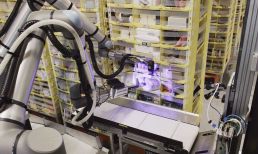Amazon Introduces First Robot With Sense of Touch

Amazon debuted Vulcan, a fulfillment center robot with a sense of touch, according to a Wednesday (May 7) blog post.
The average robot is “numb and dumb,” particularly those operating in commercial settings, Aaron Parness, Amazon director of applied science, said in the post.
“In the past, when industrial robots have unexpected contact, they either emergency stop or smash through that contact,” he said. “They often don’t even know they have hit something because they cannot sense it.”
Vulcan is built using advances in robotics, engineering and physical artificial intelligence to do its job, per the post.
While it’s not the first Amazon robot that can pick things up, its sense of touch — that is, its ability to grasp when and how it makes contact with an object — offers new ways for Amazon to bolster its operation-related jobs and facilities, the post said.
“Vulcan represents a fundamental leap forward in robotics,” Parness said in the post. “It’s not just seeing the world, it’s feeling it, enabling capabilities that were impossible for Amazon robots until now.”
Amazon’s fulfillment centers feature compartments designed to hold up to 10 items. Fitting an item into one of these spaces can be tough for robots that lack human-like dexterity. Vulcan has “a similar kind of finesse,” according to the post.
“Vulcan can easily manipulate objects within those compartments to make room for whatever it’s stowing because it knows when it makes contact and how much force it’s applying and can stop short of doing any damage,” the post said. “Vulcan does this using an ‘end of arm tooling’ that resembles a ruler stuck onto a hair straightener, plus force feedback sensors that tell it how hard it’s pushing or how firmly it’s holding something, so it can stay below the point at which it risks doing damage.”
The announcement followed reports from February that Amazon aims to glean savings from its robotics efforts as it increases spending on AI.
Also in February, PYMNTS spoke with Jenny Shern, general manager at robot builder NexCOBOT, about the challenges of introducing humanoid robots to households.
“[I]mplementing humanoid robots into household settings is a more complex advancement because, unlike factories, household environments are highly dynamic, and tasks will vary significantly from one home to another,” Shern said.
For all PYMNTS digital transformation and AI coverage, subscribe to the daily Digital Transformation and AI Newsletters.



